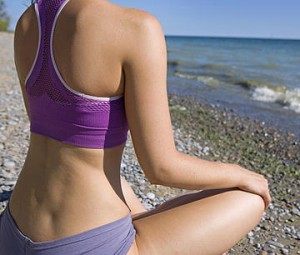While it’s often completely dismissed or just mistaken as upper back pain, middle back pain relates to inflammation surrounding the thoracic region of the spine. Running from the base of your neck to the bottom of your rib cage, the thoracic spine doesn’t move very much, explains Russel C. Huang, MD, an orthopedic spine surgeon with the Hospital for Special Surgery in New York City.
That’s good news for people suffering from middle back pain. Since the thoracic spine doesn’t contort quite the way the upper and lower spine do, its discs aren’t subject to the same amount of wear and tear, he says. That means middle back pain doesn’t typically originate in the spine, but actually comes down to strains in the muscles that support the spine—especially in strong-boned young women.
Here are five ways to relieve the pain and to keep it from coming back:
1. Perfect your posture.
As with most back pain, poor posture plays a big role in middle back pain, says physical therapist and certified strength and conditioning specialist Tony D’Angelo, PT, CSCS, vice president of clinical operations at Professional Physical Therapy in New York City. When you spend hours sitting at your computer with rounded shoulders, the muscles in your back are forced to work overtime to support your shoulders and neck. “They become so fatigued that when you go to lift a box or work out in the weight room, it’s easy for that extra movement to be the straw that breaks the camel’s back,” he says. No pun intended.
To find correct posture, D’Angelo recommends to sit as tall as you can in your desk chair. Pull your shoulders back as far as they can, then come back a third. That’s the sweet spot.
2. Stretch your chest.
Sitting up straight might not be as easy as it sounds. If your back muscles have been perpetually stretched and your shoulders rounded for months or years on end, the muscles in your chest are likely incredibly tight. That forces you into an even more hunched position, and continues the cycle, D’Angelo says.
To relax your chest muscles, try the doorway stretch. Stand in a doorway with your forearms braced against its sides with your upper arms parallel to the floor. Step forward and lean your upper body forward until you feel a gentle stretch in your chest.
3. Work out knots.
Worn-out middle back muscles go hand-in-hand with pain in the deep fascia, the connective tissue that covers each muscle, Huang says. Myofascial release therapies, such as massage and foam rolling the sensitive spots, can help to loosen up the tissue and the underlying muscle, relieving pain.
4. Talk to your doctor.
If at-home therapies aren’t relieving your pain, Huang recommends visiting your doctor for a referral to a physician who specializes in back pain. Scoliosis (often—though not always—diagnosed during adolescence) can cause serious pain, particularly in the middle back. Luckily, if scoliosis is responsible for your discomfort, physical therapy is often all that’s needed to relieve the pain, he says.
5. Strengthen your back.
You don’t want to subject already fatigued muscles to more work. But once you’ve found some relief through massage, stretching, and the like, strengthening the muscles in your middle back can further help you correct your posture and eliminate pain, D’Angelo says.
Particularly helpful for strengthening the muscles in your middle back, including your traps, lats, and periscapular muscles (which support and stabilize your shoulder blades), are rows, he says. Try the the Gimme a Y! Gimme a T! or bent-over row, shown below.
Search from:http://www.fitnessmagazine.com/health/injury/back/middle-back-pain/